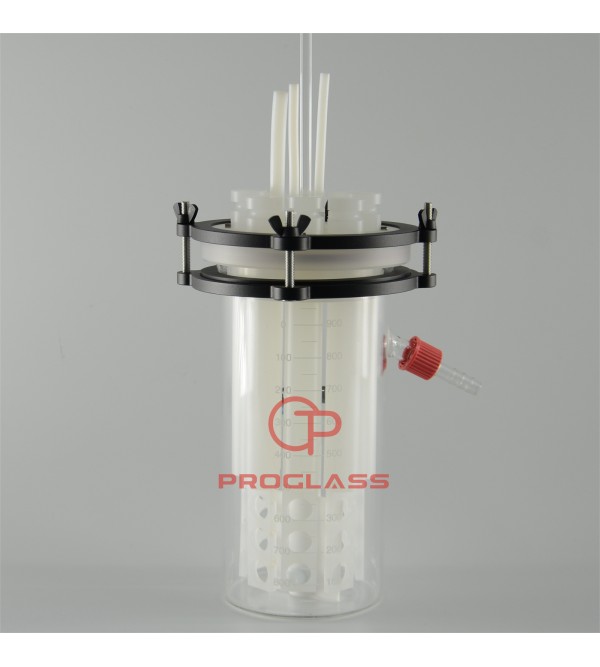The CDC Biofilm Reactor® consists of eight (8) polypropylene coupon holder rods suspended from a UHMW-polyethylene ported lid. The coupon holder rods can accommodate three 1/2 in. (12.7 mm) diameter coupons each. The lid with coupon holders and coupons is mounted in a 1 liter glass vessel with side-arm discharge port. A liquid growth media / biocide / etc. is circulated through the vessel while mixing and shear is generated by a magnetic stir bar/vane rotated by a magnetic stir plate.
Sampling of the coupons is conducted by aseptically removing individual coupon holder rods with accompanying coupons (3). The coupon holder or a blank is replaced in the lid after sampling to allow the time course experiment to continue. The coupon removed from the reactor vessel is then used for treatment evaluations, scraped or sonicated to collect the biofilm sample for further study, or imaged using microscopy and image analysis. The CDC Biofilm Reactor® is autoclavable and re-useable. The total liquid volume is approximately 350 ml. A variety of coupon materials are available, including plastics, metals, and ceramics.
CDC Reactor Description
The CDC Reactor (CBR), Figure 1, is a one-liter vessel with an effluent spout at
approximately 400 ml. Continuous mixing of the reactor’s bulk fluid is provided by a
baffled stir bar that is magnetically driven. An UHMW polyethylene top supports eight
independent rods. Each rod houses three removable coupons ( growth surfaces)
for a total of 24 sampling opportunities. The coupons may be constructed from a variety
of materials, for example: polycarbonate, porcelain, mild steel, stainless steel, PVC,
vinyl, glass, etc. The coupons experience a consistent high shear from the rotation of
the baffled stir bar. A researcher may vary shear by altering the baffle’s rotational
speed. The CBR operates as a continuous flow stirred tank reactor (CFSTR), meaning
nutrients are continuously pumped into and flow out of the reactor at the same rate. A
CFSTR offers the following advantages:
• the bulk fluid (all the fluid in the reactor) is assumed to be well mixed (no
gradients);
• the surfaces within the reactor experience fluid shear (force opposing flow) from
the mixing;
• the reactor can achieve steady state conditions which eliminates all terms that
depend upon time in the mathematical representation of the reactor. This
simplifies the mathematics necessary to calculate the reduction in
accumulation as a result of a treatment;
• the residence time (time for one reactor sized volume of liquid to flow through the
reactor) in the reactor is easily adjusted to select for growth for various
species of bacteria;
• the nutrient feed may be specified and adapted for various bacteria or conditions
(for example to represent a swimming pool environment or the white water
associated with the paper industry);
• a portion of the reactor’s effluent (waste) may be recycled back into the reactor or
become the feed of a second reactor;
• with simple modifications, a CSFTR can be operated anaerobically (without
oxygen). This increases the number of relevant environments that can be
modeled using this design.
In addition to the list of advantages above, the CBR offers additional advantages:
• the growth surfaces (a.k.a. coupons) are interchangeable with a current
reactor that BioSurface Technology manufactures and sells;
• 24 sampling opportunities;
• removable rods that allow for intermittent removal; control and treated data from
the same reactor; and
• a baffled stirrer provides for consistent shear across all the coupons.
Tags: CDC biofilm Reactor






